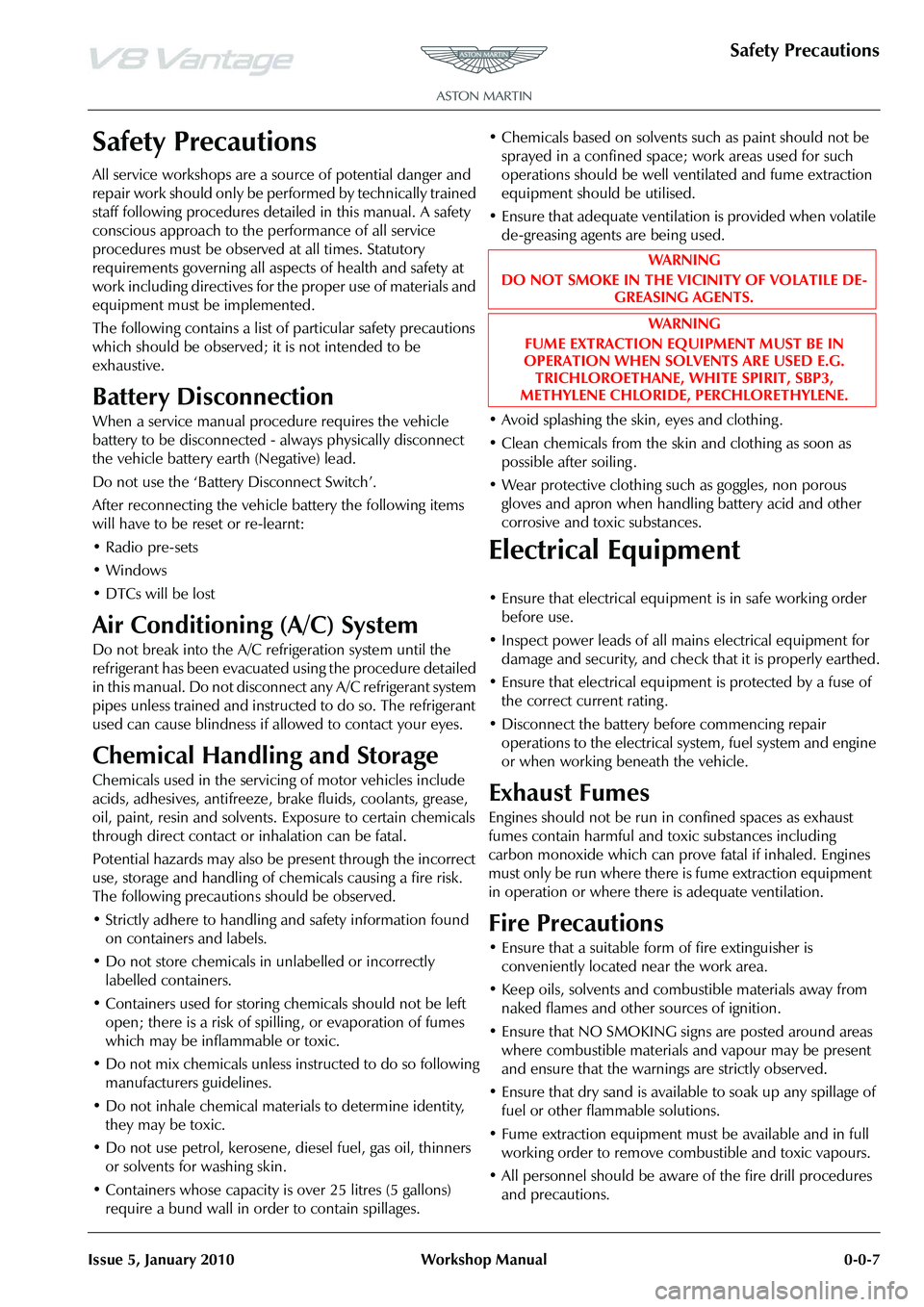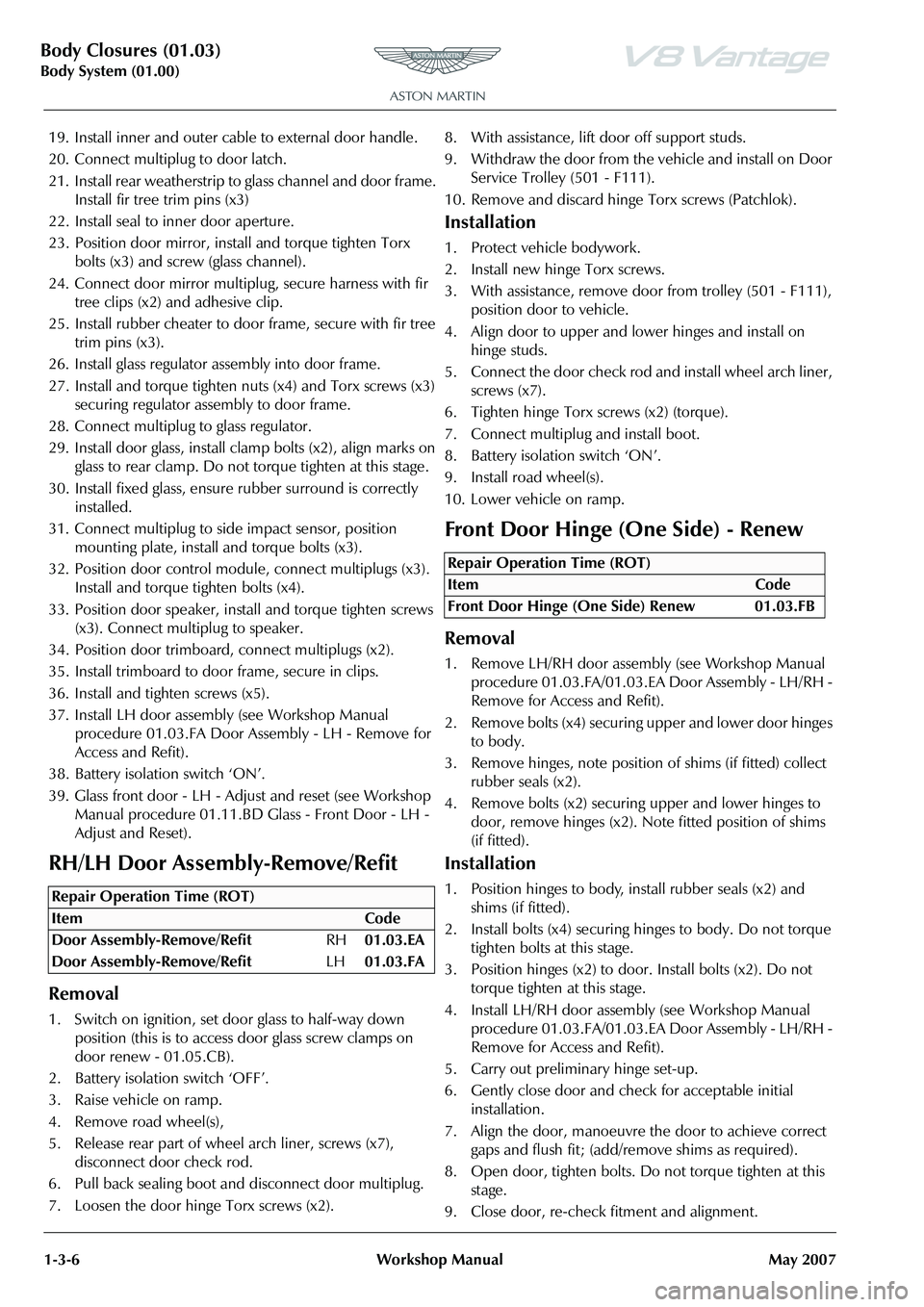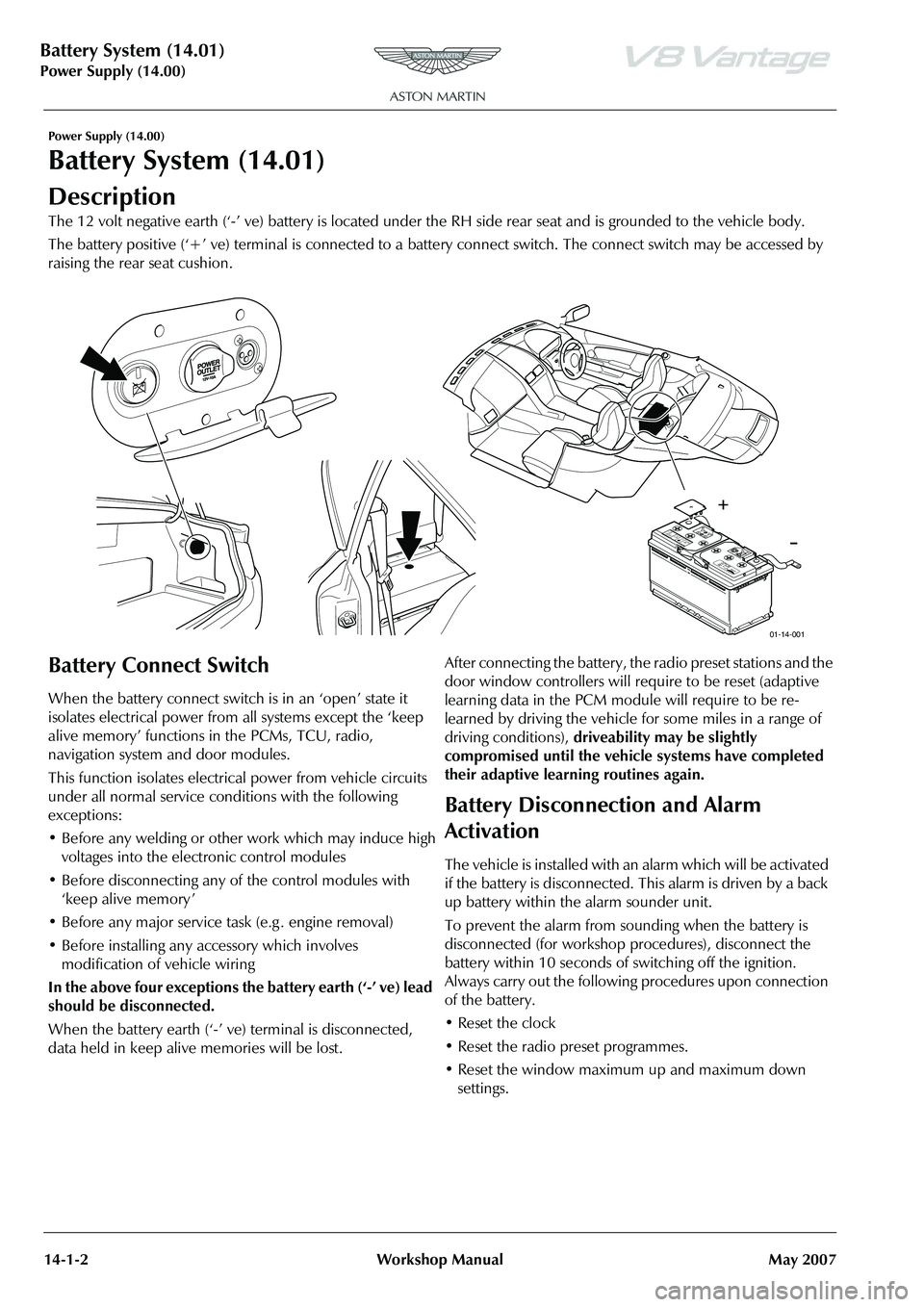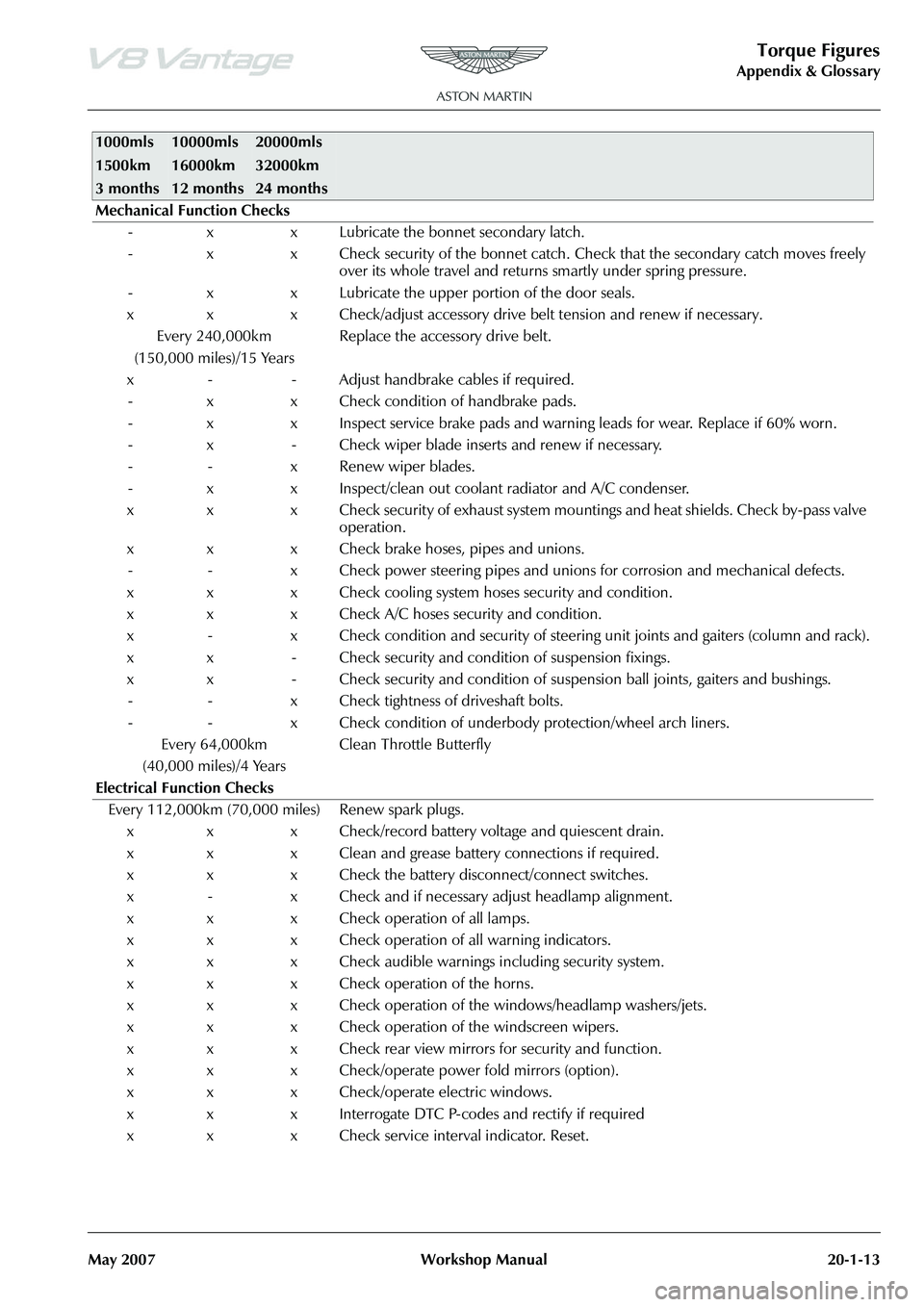service reset ASTON MARTIN V8 VANTAGE 2010 Workshop Manual
[x] Cancel search | Manufacturer: ASTON MARTIN, Model Year: 2010, Model line: V8 VANTAGE, Model: ASTON MARTIN V8 VANTAGE 2010Pages: 947, PDF Size: 43.21 MB
Page 7 of 947

Safety Precautions
Issue 5, January 2010 Workshop Manual 0-0-7
Safety Precautions
All service workshops are a source of potential danger and
repair work should only be performed by technically trained
staff following procedures detailed in this manual. A safety
conscious approach to the performance of all service
procedures must be observed at all times. Statutory
requirements governing all aspects of health and safety at
work including directives for the proper use of materials and
equipment must be implemented.
The following contains a list of particular safety precautions
which should be observed; it is not intended to be
exhaustive.
Battery Disconnection
When a service manual procedure requires the vehicle
battery to be disconnected - always physically disconnect
the vehicle battery earth (Negative) lead.
Do not use the ‘Battery Disconnect Switch’.
After reconnecting the vehicle battery the following items
will have to be reset or re-learnt:
•Radio pre-sets
•Windows
• DTCs will be lost
Air Conditioning (A/C) System
Do not break into the A/C refrigeration system until the
refrigerant has been evacuated using the procedure detailed
in this manual. Do not disconne ct any A/C refrigerant system
pipes unless trained and instructed to do so. The refrigerant
used can cause blindness if allowed to contact your eyes.
Chemical Handling and Storage
Chemicals used in the servicing of motor vehicles include
acids, adhesives, antifreeze, brake fluids, coolants, grease,
oil, paint, resin and solvents. Exposure to certain chemicals
through direct contact or inhalation can be fatal.
Potential hazards may also be present through the incorrect
use, storage and handling of chemicals causing a fire risk.
The following precaution s should be observed.
• Strictly adhere to handling and safety information found on containers and labels.
• Do not store chemicals in unlabelled or incorrectly labelled containers.
• Containers used for storing chemicals should not be left open; there is a risk of spilling , or evaporation of fumes
which may be inflammable or toxic.
• Do not mix chemicals unless instructed to do so following manufacturers guidelines.
• Do not inhale chemical materials to determine identity, they may be toxic.
• Do not use petrol, kerosene, diesel fuel, gas oil, thinners or solvents for washing skin.
• Containers whose capacity is over 25 litres (5 gallons) require a bund wall in order to contain spillages. • Chemicals based on solvents such as paint should not be
sprayed in a confined space; work areas used for such
operations should be well ve ntilated and fume extraction
equipment should be utilised.
• Ensure that adequate ventilation is provided when volatile de-greasing agents are being used.
• Avoid splashing the skin, eyes and clothing .
• Clean chemicals from the skin and clothing as soon as
possible after soiling .
• Wear protective clothing such as goggles, non porous gloves and apron when handling battery acid and other
corrosive and toxic substances.
Electrical Equipment
• Ensure that electrical equipment is in safe working order before use.
• Inspect power leads of all mains electrical equipment for damage and security, and check that it is properly earthed.
• Ensure that electrical equipment is protected by a fuse of the correct current rating .
• Disconnect the battery before commencing repair operations to the electrical sy stem, fuel system and engine
or when working beneath the vehicle.
Exhaust Fumes
Engines should not be run in confined spaces as exhaust
fumes contain harmful and to xic substances including
carbon monoxide which can prove fatal if inhaled. Engines
must only be run where there is fume extraction equipment
in operation or where there is adequate ventilation.
Fire Precautions
• Ensure that a suitable form of fire extinguisher is conveniently located near the work area.
• Keep oils, solvents and combustible materials away from naked flames and other sources of ignition.
• Ensure that NO SMOKING signs are posted around areas where combustible materials and vapour may be present
and ensure that the warnings are strictly observed.
• Ensure that dry sand is availabl e to soak up any spillage of
fuel or other flammable solutions.
• Fume extraction equipment must be available and in full working order to remove combustible and toxic vapours.
• All personnel should be aware of the fire drill procedures and precautions. WAR NI NG
DO NOT SMOKE IN THE VICINITY OF VOLATILE DE- GREASING AGENTS.
WAR NI NG
FUME EXTRACTION EQUIPMENT MUST BE IN
OPERATION WHEN SOLVENTS ARE USED E.G. TRICHLOROETHANE, WHITE SPIRIT, SBP3,
METHYLENE CHLORIDE, PERCHLORETHYLENE.
Page 32 of 947

Body Closures (01.03)
Body System (01.00)1-3-6 Workshop Manual May 2007
19. Install inner and outer cable to external door handle.
20. Connect multiplug to door latch.
21. Install rear weatherstrip to glass channel and door frame. Install fir tree trim pins (x3)
22. Install seal to inner door aperture.
23. Position door mirror, install and torque tighten Torx bolts (x3) and screw (glass channel).
24. Connect door mirror multip lug, secure harness with fir
tree clips (x2) and adhesive clip.
25. Install rubber cheater to door frame, secure with fir tree trim pins (x3).
26. Install glass regulator as sembly into door frame.
27. Install and torque tighten nuts (x4) and Torx screws (x3) securing regulator assembly to door frame.
28. Connect multiplug to glass regulator.
29. Install door glass, install clamp bolts (x2), align marks on glass to rear clamp. Do not torque tighten at this stage.
30. Install fixed glass, ensure rubber surround is correctly installed.
31. Connect multiplug to side impact sensor, position
mounting plate, install and torque bolts (x3).
32. Position door control modu le, connect multiplugs (x3).
Install and torque tighten bolts (x4).
33. Position door speaker, install and torque tighten screws (x3). Connect multiplug to speaker.
34. Position door trimboard, connect multiplugs (x2).
35. Install trimboard to door frame, secure in clips.
36. Install and tighten screws (x5).
37. Install LH door assembly (see Workshop Manual procedure 01.03.FA Door Assembly - LH - Remove for
Access and Refit).
38. Battery isolation switch ‘ON’.
39. Glass front door - LH - Adjust and reset (see Workshop Manual procedure 01.11.BD Glass - Front Door - LH -
Adjust and Reset).
RH/LH Door Assembly-Remove/Refit
Removal
1. Switch on ignition, set door glass to half-way down position (this is to access door glass screw clamps on
door renew - 01.05.CB).
2. Battery isolation switch ‘OFF’.
3. Raise vehicle on ramp.
4. Remove road wheel(s),
5. Release rear part of whee l arch liner, screws (x7),
disconnect door check rod.
6. Pull back sealing boot and disconnect door multiplug.
7. Loosen the door hinge Torx screws (x2). 8. With assistance, lift door off support studs.
9. Withdraw the door from the vehicle and install on Door
Service Trolley (501 - F111).
10. Remove and discard hinge Torx screws (Patchlok).
Installation
1. Protect vehicle bodywork.
2. Install new hinge Torx screws.
3. With assistance, remove door from trolley (501 - F111),
position door to vehicle.
4. Align door to upper and lower hinges and install on hinge studs.
5. Connect the door check rod and install wheel arch liner, screws (x7).
6. Tighten hinge Torx screws (x2) (torque).
7. Connect multiplug and install boot.
8. Battery isolation switch ‘ON’.
9. Install road wheel(s).
10. Lower vehicle on ramp.
Front Door Hinge (One Side) - Renew
Removal
1. Remove LH/RH door assemb ly (see Workshop Manual
procedure 01.03.FA/01.03.EA Door Assembly - LH/RH -
Remove for Access and Refit).
2. Remove bolts (x4) securing upper and lower door hinges to body.
3. Remove hinges, note position of shims (if fitted) collect
rubber seals (x2).
4. Remove bolts (x2) securing upper and lower hinges to door, remove hinges (x2). No te fitted position of shims
(if fitted).
Installation
1. Position hinges to body, install rubber seals (x2) and shims (if fitted).
2. Install bolts (x4) securing hi nges to body. Do not torque
tighten bolts at this stage.
3. Position hinges (x2) to door. Install bolts (x2). Do not torque tighten at this stage.
4. Install LH/RH door assemb ly (see Workshop Manual
procedure 01.03.FA/01.03.EA Door Assembly - LH/RH -
Remove for Access and Refit).
5. Carry out preliminary hinge set-up.
6. Gently close door and check for acceptable initial installation.
7. Align the door, manoeuvre the door to achieve correct gaps and flush fit; (add/remove shims as required).
8. Open door, tighten bolts. Do not torque tighten at this stage.
9. Close door, re-check fitment and alignment.Repair Operation Time (ROT)
Repair Operation Time (ROT)
ItemCode
Front Door Hinge (One Side) Renew 01.03.FB
Page 657 of 947

Battery System (14.01)
Power Supply (14.00)14-1-2 Workshop Manual May 2007
Power Supply (14.00)
Battery System (14.01)
Description
The 12 volt negative earth (‘-’ ve) battery is located under the RH side rear seat and is grounded to the vehicle body.
The battery positive (‘+’ ve) terminal is connected to a battery connect switch. The connect switch may be accessed by
raising the rear seat cushion.
Battery Connect Switch
When the battery connect switch is in an ‘open’ state it
isolates electrical power from all systems except the ‘keep
alive memory’ functions in the PCMs, TCU, radio,
navigation system and door modules.
This function isolates electri cal power from vehicle circuits
under all normal service conditions with the following
exceptions:
• Before any welding or other work which may induce high voltages into the electronic control modules
• Before disconnecting any of the control modules with ‘keep alive memory ’
• Before any major service task (e.g . engine removal)
• Before installing any accessory which involves modification of vehicle wiring
In the above four exceptions the battery earth (‘-’ ve) lead
should be disconnected.
When the battery earth (‘-’ ve) terminal is disconnected,
data held in keep alive memories will be lost. After connecting the battery, the radio preset stations and the
door window controllers will require to be reset (adaptive
learning data in the PCM module will require to be re-
learned by driving the vehicle for some miles in a range of
driving conditions),
driveability may be slightly
compromised until the vehicle systems have completed
their adaptive learning routines again.
Battery Disconnection and Alarm
Activation
The vehicle is installed with an alarm which will be activated
if the battery is disconnected. This alarm is driven by a back
up battery within the alarm sounder unit.
To prevent the alarm from so unding when the battery is
disconnected (for workshop procedures), disconnect the
battery within 10 seconds of switching off the ignition.
Always carry out the following procedures upon connection
of the battery.
• Reset the clock
• Reset the radio preset programmes.
• Reset the window maximum up and maximum down settings.
Pb
A
ST O
N
M A
R
TI
N
S H I
E L
D
E YE
S
NO S
U L
F U R
IC
A C I
DF
LU
SH
E
YES
I M
MED IA T
E LY
W IT
H
W A
T
E R
G ET
M ED
IC
AL
H ELP
F A
STSPA
R
KS
F LA
M
ES
S M
OKIN
GD AN G ER / P
OIS
ONEXP L
O S
IV E
G ASE
SC AN
C A
U SE C
A
N C A
U SE
B L
IN DN
ESS
O R
S E
V ER E
B U RNS
B
LI
NDN
ES S
O R
IN JU R
YK EEP
O UT
O F T
HE R
EA C
H O F C H
IL DR
EN D O N
OT
TI P: K EEP
V E
N T C A
PS
T IG HT
A N D L E
VE L!
1
2 V
1
2 V 9
0A
h
9
0A
h
M IN S
M
IN S
( S
AE
)
(
S
AE
)RC
RC6
80 A
M
PS
6
80 A
M
PS2R
83-1
065 5-A
A
2
R
83-1
065 5-A
A170
1 70
01-14-001
Page 752 of 947

Torque Figures
Appendix & Glossary
May 2007 Workshop Manual 20-1-13
Mechanical Function Checks - x x Lubricate the bonnet secondary latch.
- x x Check security of the bonnet catch. Ch eck that the secondary catch moves freely
over its whole travel and returns smartly under spring pressure.
- x x Lubricate the upper portion of the door seals.
x x x Check/adjust accessory drive belt tension and renew if necessary. Every 240,000km
(150,000 miles)/15 Years Replace the accessory drive belt.
x - - Adjust handbrake cables if required. - x x Check condition of handbrake pads.
- x x Inspect service brake pads and warnin g leads for wear. Replace if 60% worn.
- x - Check wiper blade inserts and renew if necessary.
- - x Renew wiper blades.
- x x Inspect/clean out coolant radiator and A/C condenser.
x x x Check security of exhaust system mountings and heat shields. Check by-pass valve operation.
x x x Check brake hoses, pipes and unions. - - x Check power steering pipes and unions for corrosion and mechanical defects.
x x x Check cooling system hoses security and condition.
x x x Check A/C hoses security and condition.
x - x Check condition and security of steering unit joints and gaiters (column and rack).
x x - Check security and condition of suspension fixings.
x x - Check security and condition of susp ension ball joints, gaiters and bushings.
- - x Check tightness of driveshaft bolts.
- - x Check condition of underbody protection/wheel arch liners.
Every 64,000km
(40,000 miles)/4 Years Clean Throttle Butterfly
Electrical Function Checks Every 112,000km (70,000 miles) Renew spark plugs. x x x Check/record battery voltage and quiescent drain.
x x x Clean and grease battery connections if required.
x x x Check the battery disconnect/connect switches.
x - x Check and if necessary adjust headlamp alignment.
x x x Check operation of all lamps.
x x x Check operation of all warning indicators.
x x x Check audible warnings including security system.
x x x Check operation of the horns.
x x x Check operation of the windows/headlamp washers/jets.
x x x Check operation of the windscreen wipers.
x x x Check rear view mirrors for security and function.
x x x Check/operate power fold mirrors (option).
x x x Check/operate electric windows.
x x x Interrogate DTC P-codes and rectify if required
x x x Check service interval indicator. Reset.
1000mls
1500km
3 months10000mls
16000km
12 months20000mls
32000km
24 months